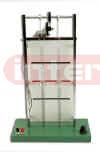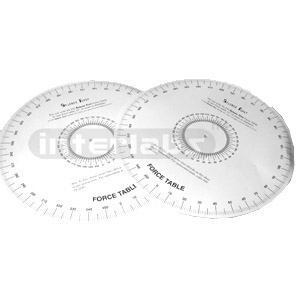| |
 Click to Enlarge
Click to Enlarge
|
Ballistics Car (1600-9)
Demonstrates that the forward velocity of a ball ejected vertically is the same as the forward velocity of the vehicle from which it was ejected. Includes a vertical spring loaded barrel and a 1" diameter steel ball. The ejection mechanism has two settings which are controlled by a release pin and cord. Size 250 x 60 x 140mm.
See Enlarge
|
|
|
|
 Click to Enlarge
Click to Enlarge
|
Pulley (1607)
All pulley's are sturdily constructed with an aluminum housing and plastic colored wheel.
1607-1 Plastic Pulley, Single
1607-2 Plastic Pulley, Double
1607-3 Plastic Pulley, Triple
1607-4 Plastic Pulley, Quadruple
1607-5 Plastic Pulley, Double Tandem
1607-6 Plastic Pulley, Triple Tandem
See Enlarge
|
|
|
|
 Click to Enlarge
Click to Enlarge
|
Forced Oscillation & Resonance Demonstration (1812)
The apparatus demonstrates the resonance point of two weights with different natural frequencies. Included is 2-weights, 2- cams driven by a 6 volt DC motor with speed control and 4 - springs. The speed control is used to adjust the frequency of applied force for resonance.
See Enlarge
|
|
|
|
 Click to Enlarge
Click to Enlarge
|
Solar Cell Demonstration (1849-2)
This is a great desk top item and attention getter. Four powerful solar cells are mounted on a revolving disk and motor. This in turn is mounted to a plastic stand and base. Watch as the entire disk, solar cells included, begin to whirl around when the unit is placed in the sun.
See Enlarge
|
|
|
|
 Click to Enlarge
Click to Enlarge
|
Gasoline Engine Model (1861)
This unit is to show to the student about the working principle of gasoline engine made of aluminum.
1861P Same as above, only made of Plastic.
See Enlarge
|
|
|
|
 Click to Enlarge
Click to Enlarge
|
Diesel Engine Model (1862)
This unit is to show to the student about the working principle of diesel engine made of aluminum.
1862P Same as above, only made of Plastic.
See Enlarge
|
|
|
|
 Click to Enlarge
Click to Enlarge
|
Roman Arch Set (1868)
This working model of the famous Roman Arch is an excellent study in Physics and Engineering. When correctly assembled, it will support the weight of a man. Size 26cm x 33cm.
* 23 hardwood blocks in 6 distinct shapes
* Pre-drilled wooden buttress
* 4 screws for assembling buttress
* Manual with full-scale template of arch.
See Enlarge
|
|
|
|
 Click to Enlarge
Click to Enlarge
|
Maxwell's Wheel (1886)
Used for demonstrating momentum, conservation of energy and torque. This unit which is basically a large flywheel is suspended by two strong cords. These cords are wound around the shaft of the wheel and then released. The wheel will unwind as it falls but will wind itself back up as the momentum carries the wheel upward in the opposite direction. This oscillation process will continue for several moments as the wheel slowly lose momentums and travels less each time.
See Enlarge
|
|
|
|
 Click to Enlarge
Click to Enlarge
|
Free Fall Apparatus, 110V, 1.2M (1888)
This item is used to study the rate of an item in free fall specifically a small steel ball. This ball is held by an electromagnet and when released it's rate of fall is measured by a photo-gate and timer ( not included ).
See Enlarge
|
|
|
|
 Click to Enlarge
Click to Enlarge
|
Economy Free Fall Tube (1888-120)
This economical device demonstrates how aerodynamic forces, which dictate that lighter objects experience a lesser acceleration than heavier objects, are virtually eliminated when in a vacuum environment. This unit features a durable, clear plastic tube, 120cm long. The hose cock is connected to any standard vacuum pump (not included) to remove that air from tube.
See Enlarge
|
|
|
|
 Click to Enlarge
Click to Enlarge
|
Student Free Fall Apparatus (1888-S)
This device was designed for student labs for the high school through college levels. Easy to set up, use, and store. Comes complete with spark timer and recording tapes. Each tape can record up to three free falls. 30"x 6"x 7", 3.8lbs.
See Enlarge
|
|
|
|
 Click to Enlarge
Click to Enlarge
|
Horizontal Cast and Collision Tester (1889)
Here is a unique way to study horizontal and vertical motion, conservation of energy, and momentum. A track mounted to a vertical board directs one or two carts, casting them into a free fall. A brush projecting from the back side of the carts, marks the path of the cart as it falls. Weights can be added to the carts to study the effects of increased mass on momentum.
See Enlarge
|
|
|
|
 Click to Enlarge
Click to Enlarge
|
Vertical Force Board (1892)
Static forces, torque and rotational equilibrium can be visually exported with this unit that measures 30 inches tall. A circular plate 8-3/4" in diameter revolves on a low friction pin. This plate contains 4 sets of holes with 8 holes in each set. Each set of holes are spaced a different distance from the center. Rotational forces are studied by attaching pins with hanging weights into the various holes and by measuring forces with a spring scale.
See Enlarge
|
|
|
|
 Click to Enlarge
Click to Enlarge
|
Spark Timers (2008)
Acceleration, Spark Timer with accessories. This apparatus is used for determining the rate of acceleration in a falling weight, calculating the speed of moving cart or studying the forces of friction. A paper strip is pilled through the timer while a spark at a very precise interval is created which burns tiny dots into the paper strip as it passes. The faster the strip passes through the sparks the large distance between dots. It is easy then for the student to calculate the rate of speed for acceleration. As an added benefit, everything on the spark timer is enclosed for safety. 110 volt.
See Enlarge
|
|
|
|
 Click to Enlarge
Click to Enlarge
|
Digital Timer and Photogate (2009)
The solid state apparatus is a must for any physics class and is perfect for our air track and free fall apparatus. Two photo-gates are included, each with it's own shielded connecting cord and mounting screws. The timer has functions for timing, mechanical periods of oscillation, acceleration, collision velocities, counting and more.
See Enlarge
|
|
|
|








